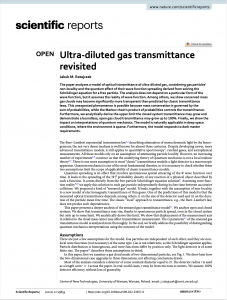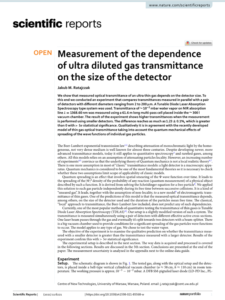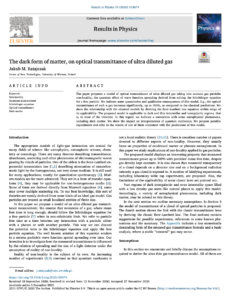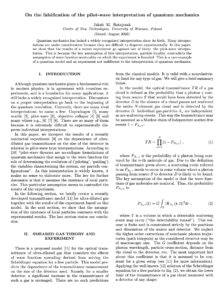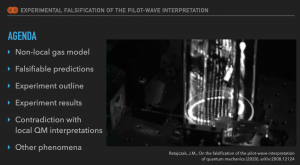Ultra‐diluted gas transmittance
revisited
Abstract: The paper analyzes a model of optical transmittance of ultra‐diluted gas, considering gas particles’ non‐locality and the quantum effect of their wave function spreading derived from solving the Schrödinger equation for a free particle. The analysis does not depend on a particular form of the wave function, but it assumes the reality of wave function. Among others, we show conserved mass gas clouds may become significantly more transparent than predicted by classic transmittance laws. This unexpected phenomenon is possible because mass conservation is governed by the sum of probabilities, while the Markov chain’s product of probabilities controls the transmittance. Furthermore, we analytically derive the upper limit the closed system transmittance may grow and demonstrate a boundless, open gas cloud transmittance may grow up to 100%. Finally, we show the impact on interpretations of quantum mechanics. The model is naturally applicable in deep space conditions, where the environment is sparse. Furthermore, the model responds to dark matter requirements.
Scientific Reports 12: 19859 (2022)
DOI: 10.1038/s41598-022-23657-0
Full-text: nature.com
Measurement of the dependence of ultra diluted gas transmittance on the size of the detector
Abstract: We show that measured optical transmittance of an ultra thin gas depends on the detector size. To this end we conducted an experiment that compares transmittances measured in parallel with a pair of detectors with different diameters ranging from 2μm to 200μm. A Tunable Diode Laser Absorption Spectroscopy type system was used. Transmittance of ∼0.01 mbar water vapor on NIR absorption line λ=1368.60nm was measured using a 60m long multi-pass cell placed inside the 300l vacuum chamber. The result of the experiment shows higher transmittances when the measurement is performed using smaller detectors. The difference reaches as much as 1.23 ±0.1 %, which is greater than 0 with >5σ statistical significance. Qualitatively it is in agreement with the recently developed model of thin gas optical transmittance taking into account the quantum mechanical effects of spreading of the wave functions of individual gas particles.
Scientific Reports 11, 6221 (2021)
DOI: 10.1038/s41598-021-85568-w
Full-text: nature.com
The dark form of matter, on optical transmittance of ultra diluted gas
Abstract: The paper proposes a model of optical transmittance of ultra diluted gas taking into account gas particles non-locality, the quantum effect of wave function spreading derived from solving the Schrödinger equation for a free particle. We indicate some quantitative and qualitative consequences of this model. E.g., the optical transmittance of such a gas increases significantly, up to 100%, as compared to the classical predictions. We show the relationship with the classical models by deriving the Beer–Lambert law equation within range of its applicability. The proposed model is applicable to dark and thin interstellar and intergalactic regions, that is, to most of the Universe. In this regard, we indicate a connection with some astrophysical phenomena, including dark matter. We show the impact on interpretations of quantum mechanics. We propose possible experiments and refer to the results of one of them consistent with the predictions of this model.
Results in Physics vol. 19, 103674 (2020)
DOI: 10.1016/j.rinp.2020.103674
Full-text: sciencedirect.com
On the falsification of the pilot-wave interpretation of quantum mechanics
Abstract: Quantum mechanics has lacked a widely recognized interpretation since its birth. Many interpretations are under consideration because they are difficult to disprove experimentally. In this paper, we show that the results of a recent experiment go against one of them: the pilot-wave interpretation. This is because the key assumption of this interpretation, particle locality, contradicts the assumption of wave function non-locality on which the experiment is founded. This is a rare example of a quantum model and an experiment not indifferent to the interpretation of quantum mechanics.
Preprint (2020)
arXiv: 2008.12124
Full-text: arxiv.com
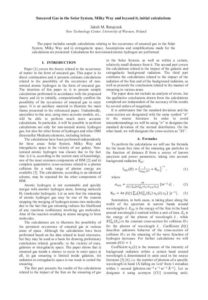
Smeared Gas in the Solar System, Milky Way and beyond it, initial calculations
Abstract: The paper includes sample calculations relating to the occurrence of smeared gas in the Solar System, Milky Way and in extragalactic space. Assumptions and simplifications made for the calculations are presented. Calculations for non-ionized atomic hydrogen are performed.
Available upon request
Experimental falsification of the pilot-wave interpretation of Quantum Mechanics,
Quantum 2020 talk (video)
Abstract: Quantum mechanics has lacked a widely recognized interpretation since its birth. Many interpretations are under consideration because they are difficult to disprove experimentally. In this short video, I show how the results of a recent experiment go against one of them: the pilot-wave interpretation. This is because the key assumption of this interpretation, particle locality, contradicts the assumption of wave function nonlocality on which the experiment is founded. This is a rare example of a quantum model and an experiment not indifferent to the interpretation of quantum mechanics.
Quantum 2020 talk (2020)
Video: youtube.com
